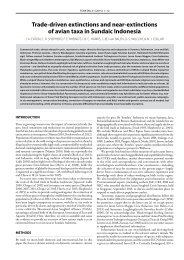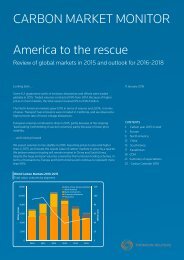Emissions Trading Worldwide
1TbjEHd
1TbjEHd
You also want an ePaper? Increase the reach of your titles
YUMPU automatically turns print PDFs into web optimized ePapers that Google loves.
Beijing (Pilot) <strong>Emissions</strong> <strong>Trading</strong> System<br />
in force<br />
emissions coverage (Mtco 2 e, 2015)<br />
Liable entities<br />
50.0 551<br />
Gas coverage<br />
allocation<br />
Offsets & Credits<br />
co2 only<br />
free allocation<br />
domestic<br />
On 28 November 2013, Beijing was the third Chinese region, after<br />
Shenzhen and Shanghai, to launch its pilot ETS. The pilot covers<br />
about 40% of the city’s total emissions, including both direct and<br />
indirect emissions from electricity providers, the heating sector,<br />
cement, petrochemicals, other industrial enterprises, manufacturers<br />
and major public buildings. In June 2015, the second compliance<br />
phase ended with 100% compliance.<br />
Phases and Allocation<br />
<strong>Trading</strong> periods Three years (2013–2015) 1<br />
allocation Mainly free allocation through grandfathering based on 2009–2012<br />
emissions or emissions intensity. Benchmarking for new entrants and entities<br />
with expanded capacity.<br />
COMPLIANCE PERIOD One year (15 June)<br />
background information<br />
Flexibility<br />
Overall Ghg <strong>Emissions</strong> (excl. LULUCF) 188.1 MtCO 2 e (2012)<br />
GHG Reduction Targets By 2015 (12 th Five Year Plan): 118% reduction in carbon<br />
intensity compared to 2010 levels.<br />
ets size<br />
Cap 50MtCO 2 (Estimate, no official data published)<br />
emissions coverage<br />
covered<br />
not covered<br />
40% *<br />
60%<br />
* Estimate, no official data published<br />
GHG Covered CO 2<br />
Sectors & THRESHOLDS Industrial and non-industrial companies and entities,<br />
including electricity providers, heating sector, cement, petrochemicals,<br />
other industrial enterprises, manufacturers and service sector. With the revised<br />
inclusion threshold the transport sector will be covered as well. Inclusion<br />
thresholds: 10,000t CO 2/year, considering both direct and indirect emissions.<br />
Revision of the threshold in December 2015 to 5,000t CO 2/year will affect the<br />
cap, emissions coverage, and number of liable entities, however these numbers<br />
are not yet available.<br />
Point of regulation Mixed: Both direct emissions from the power sector<br />
and indirect emissions from electricity (and heat) consumption are included in<br />
the scheme. Electricity prices are regulated in China, and therefore a scheme<br />
based on direct emissions alone would not induce a pass-through of carbon<br />
costs via the electricity price, and would not incentivize demand-side management<br />
of electricity. The system therefore covers emissions from the power sector<br />
upstream and other sectors downstream.<br />
Number of liable entities 551 (2015)<br />
Banking and borrowing Banking allowed during the pilot phase. Borrowing<br />
is not allowed.<br />
Offsets and Credits Quantitative Limit: Domestic project-based carbon offset<br />
credits — China Certified Emission Reduction (CCER) credits — are allowed.<br />
The use of CCER credits is limited to 5% of the annual allocation. Qualitative<br />
Limit: Out of the 5% annual allocation, at least 50% must come from projects<br />
within the jurisdiction of the city of Beijing. Credits from hydropower, HFC, PFC,<br />
N 2 O and SF 6 projects are not eligible and all reductions have to be achieved<br />
after the beginning of 2013. Verified carbon emission reductions from energy<br />
saving projects and forest carbon sink projects from within the city of Beijing<br />
are also allowed.<br />
PRICE MANAGEMENT PROVISIONS In case of market fluctuations, the Beijing<br />
Development and Reform Commission (DRC) can buy or auction allowances<br />
in order to stabilize the market.<br />
compliance<br />
MRV Reporting Frequency: Annual reporting of CO 2 emissions. Verification:<br />
Third-party verification is required. Framework: The Beijing DRC has released<br />
guidelines for monitoring and reporting for the following six sectors: heat production<br />
and supply, thermal power generation, cement, petrochemicals, other<br />
industrial enterprises, and the service sector. Other: In addition to the ETS participants,<br />
all legal entities with energy consumption of more than 2,000 tons of<br />
standard coal equivalent have to report their emissions, verification is not required.<br />
Enforcement Penalties for failing to submit the emissions or verification<br />
report on time vary and can result in fines up to 50,000 CNY (EUR 7,343).<br />
Furthermore, companies failing to surrender enough allowances to match their<br />
emissions are fined three to five times the average market price over the past<br />
six months for each missing allowance.<br />
other information<br />
1 Initially, the seven Chinese pilot ETS were scheduled to end after three compliance years and be<br />
replaced by the national ETS in 2016. However, as the national ETS will not start before 2017, the pilots<br />
will likely be extended until then.<br />
Institutions involved Beijing DRC (Competent authority), China Beijing<br />
Environment Exchange (<strong>Trading</strong> platform)<br />
international carbon action partnership<br />
59




